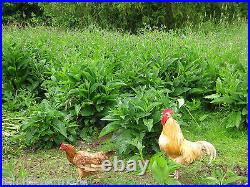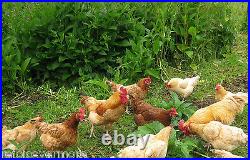


This listing is not for 10 crowns, but a combination cuttings & crowns. I offer fresh — 10 crown/ root cuttings grow over 1000 plants. I was expecting so much smaller.. I ordered a second batch. This is wild comfrey that grows on our property for hundreds of years. Does not produce seeds. Comfrey root is used to relieve pain from blunt injuries, promote healing of broken bones, sprains and bruises, reduce swelling and edema, and encourage the rapid and healthy regrowth of skin and tissue cells. Comfrey has a strong history of being used as an external application by itself or in poultices for the mending of wounds and broken bones. Comfrey has been called the bone knitter. Another study by Daniel O. Noorlander using Comfrey on streptococcus agalactia and staphylococcal bacteria, showed that when Comfrey extract (tincture) was introduced topically to the bacteria, within 20 to 30 minutes the walls of the bacteria cells weakened and then burst, destroying the bacteria. Contact healer (relieves pain and starts healing on contact). Cell proliferant helps grow new flesh and bone. Accelerates the healing process. The cell proliferant and active ingredient in Comfrey is called Allantoin. Helps with pain, repairs and heals, excellent for wounds, burns, cuts and abrasions and broken bones, high in calcium. Reduces the inflammation of pulled tendons. Extract (tincture) used topically for acne and athletes foot. Used for female problems. Comfrey tea and extract has been used as a douche for yeast infections. Poultices applied to sore and caked breasts, helps the tenderness leave very quickly. High in calcium and Vitamin C. Contains carotene (vitamin A), B12, and chlorophyll. When Comfrey extract was applied to mosquito bites, the itching stopped immediately and the swelling went down. Has been used in the following: Acne Allergies Arthritis Athletes foot Baths for sores Bed sores Bowels, ulcerated Boils Bronchitis Bruises Burns Bursitis Cold sores Congestion Coughs Digestion Douches Emphysema Female problems Fomenations Fractures Gangrene Gout Hay fever Herpes Infections Insect bites, stings Itching Lungs Mouthwash Mucous membranes Pain Poultice Skin Sores Swellings Vaginal douche Wounds Yeast infection Case History D. Cut himself on the finger with an aluminum can lid. The wound was very deep, almost to the bone. He applied fresh Comfrey poultices to the wound daily. The wound healed completely in 2-3 days. Maria Treben book “Health Through God’s Pharmacy” COMFREY Scientific name: Symphytum officinale Common names: Knit Bone, Boneset, Consound and Bruise wort Herb Details: This medicinal plant belongs to our most indispensable and valued herbs, which nature has in store for us. It grows in moist meadows, ditches and near streams, is found also near fences and in gravel pits, flowering all summer. The leaves are rough and pointed at the end. The several year old root, dark brown to black on the outside, white to yellowish within, is of the thickness of a thumb and, cut open, is sticky, almost slimy. The root is dug out in spring or autumn. The fresh plant is gathered before and during the time of flowering. The tincture of Comfrey, easily prepared, contains wonderful power. People, who suffer from rheumatism and swelling of joints and have been treated with other remedies without success, have found relief with Comfrey tincture. A woman could hardly use her right arm (the socket joint was almost unusable) and the doctor had already diagnosed paralysis. Following advice, she rubbed the tincture into the joint of the right arm daily. From day to day she felt how her complaint eased. Today she can use her arm normally and can look after her household. The leaves of Comfrey, scalded and used as a poultice and applied to paralyzed limbs caused by over exertion, dislocation, sprain or shock, help overnight. My husband’s aunt was hit by a motorcycle. She was taken to the hospital with a fracture of the hip joint; a pin was inserted and after she was cured, she left the hospital. After a year the pin should have been removed but since she had no pain and could walk soundly, she refrained from going to the arranged check-up. Everything seemed in good order, until one day she felt unbearable pain. The pin had to be removed and it was found that the bone was infected. Injections dulled the pain for short periods, but the infections did not heal. In this state she came to visit us, a picture of misery. I can state without exaggeration that warm poultices of Comfrey helped overnight. Next day the woman was able to sit and lie without pain. Since only small pieces of Comfrey roots were available in herbal shops, the clever aunt dried them a little more in the oven and ground them with a coffee grinder (a poppyseed grinder does it as well). She applied these poultices (see “directions”) until she had no more complaints. Knobs on the joints of hands and feet are made to disappear with these poultices. I would like to point out that the Comfrey meal itself, applied as a poultice, gives ease in paraplegia. Warm poultices are helpful in varicose ulcers, muscular rheumatism, gout stones, ulcers, neck pains, painful amputation stumps, and periostitis itself. A tea can be prepared from the roots and used internally for bronchitis, disorders of the digestive system, bleeding in the stomach and pleurisy. 2 to 4 cups are sipped during the day. For stomach ulcers a tea of 100 gm. Calendula and 50 gm. Knot grass (Polygnom aviculare) is recommended (see “directions”). Once again I would like to mention the Comfrey tincture. As a compress it is used most successfully for external and internal wounds, all sorts of injuries, bruises, contusions, ecchymosis and bone fractures. The leaves of Comfrey are not only used as poultices but also as additions to baths for rheumatic complaints, gout, painful bones, slipped discs and defective circulation. For defective circulation in the legs, varicose veins and as supplementary treatment of bone fractures. Comfrey sitz baths are taken. In an old German recipe Comfrey leaves are dipped into a light batter and fried in oil. There is goodness there for the whole family. DIRECTIONS: Tea preparation from the roots: 2 teaspoons of finely chopped roots are soaked in 1/4 litre cold water overnight, slightly warmed in the morning, strained and taken in sips. Tea (for stomach ulcers): A heaped teaspoon of the mixture (see text above) to 1/4 litre of boiling water, infuse for 3 minutes. 3 to 4 cups are sipped during the day. Poultice: Well dried roots are finely ground, mixed quickly with very hot water and a few drops of cooking oil and spread on a piece of linen, applied warm on the affected area and bandaged. Leaf applications (fresh): Fresh leaves are washed, beaten to a pulp and applied to the affected part. Leaf applications (hot): Comfrey leaves are scalded and applied warm. Additions to full bath: 500 gm. Fresh or dried Comfrey leaves are soaked in approx. 5 litres of cold water. Next day it is brought to the boil and the liquid is added to the bath water (see “full bath” – General Information). Sitz bath: Proceed as for full bath, but use only 200 gm. Comfrey tincture: Comfrey roots are washed and cleaned with a brush, finely chopped, loosely placed in a bottle, rye whisky or wodka poured over them and the bottle kept in the sun or near the stove for 14 days. Comfrey ointment: 4 to 6 fresh, washed Comfrey roots, depending on size, are finely chopped and added to 250 gm. Of heated lard and left to cool overnight. Next day reheated, lightly strained and pressed through a cloth, immediately poured into clean, small jars and stored in the refrigerator. This Comfrey ointment can be used instead of the meal. For treatment of wounds in humans and animals the ointment is invaluable. Comfrey wine: 2 to 5 fresh roots are finely chopped and macerated in one litre of white wine for 5 to 6 weeks. An excellent remedy for pulmonary complaints! AS a FOOD Comfrey fritters can make an economical, nutritious and quick meal. Make a batter, with egg, milk and flour, and add finely chopped comfrey leaves (omit the thick stem as it takes longer to cook). Season with salt and pepper and, if desired, onions, garlic or other herbs, to flavour. Place tablespoonfull amounts in an oiled fry pan and brown both sides. Serve fritters hot or cold for packed lunches, etc. Whole leaves can be dipped in batter and fried. A woman from Brisbane called at the farm, and shared that, when they were very poor she fed her family on comfrey fish, the leaves dipped in batter and fried. It was very delicious, she said, and added that, during their time of poverty, they were always healthy! When dipping leaves in batter, if the batter seems to coat the leaves too thickly, dip the leaves in cold water before dipping in the batter. Juice comfrey leaves with carrots, celery and other vegetables or greens. Make a comfrey smoothie; using leaves blended with pineapple juice, orange or mango. In summer, blend comfrey leaves, zucchini, avocado and carrot juice, to make a refreshing, cold soup. Comfrey used as a vegetable soup daily, has helped to relax and promote sleep for people with nervous conditions. Leaves dried and crumbled, or ground to a green flour, can be added to bread, gravy, soups, and rissoles. Dried leaves are used as a tea, sometimes used with an equal amount of China tea and sugar and milk. Combining comfrey with mint and honey, to sweeten, makes a refreshing tea combination. In his informative book, on the wonderful attributes of comfrey, Andrew Hughes says, “Comfrey is a food”. Hughes points out how medicines may have an immediate effect, the results of which may be felt almost instantly, however the effect does not last. Comfrey, on the other hand, does not act this way. Comfrey is a food, and as such, must be metabolized, like all other foods. Hughes continually stresses this point, explaining that to get the benefits of comfrey, it must be taken regularly and consistently. The effect of comfrey is longer lasting because it is built into the very cells of the body. It should be used, regularly, as a food, because it penetrates to every part of the body and brain, improving both the structure and function of each part. Comfrey contains the same structural material of which the human body is built, the proteins and minerals, plus the catalysts that enable the metabolism to operate more efficiently vitamins, enzymes, etc. Secondly, its two unique elements, vitamin B12 and allantoin act directly on the blood stream – B12 to create red corpuscles and allantoin to regulate cell formation and increase white corpuscles. Once the blood is affected by ingesting this food, the whole body benefits, even to the tiniest hair, the most remote cell, the tips of the nails, the cells of the brain, the marrow of the bones. According to Hughes, every part of the body functions better as a result of regular consumption of comfrey, and the body as a whole, is more resistant to the attacks of disease and aging. The item “Comfrey 10 Plant /Crown/cuttings Grow your own Most Indispensable Valued Herb” is in sale since Thursday, June 6, 2019. This item is in the category “Health & Beauty\Natural & Alternative Remedies\Herbal Remedies & Resins”. The seller is “rejoice_evermore” and is located in Oakville, Washington. This item can be shipped to United States.
- Formulation: Root
- Features: Salt Free
- Active Ingredients: Comfrey
- Supplement Purpose: Bones and Joints
- Ingredients: Comfrey Root
- Brand: Oakville/ Washington